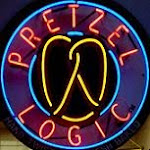
Artist: Bell Orchestre
Album: As Seen Through Windows
Year: 2009
Grade: 3.5 pretzels
One of the best concerts I ever went to was Arcade Fire at Seattle’s Paramount Theater. This must have been around 2004 or 2005 and the lineup was phenomenal. Apart from a life-changing show from Arcade Fire, I was also introduced to Wolf Parade, who were then a small, fairly unknown up-and-coming group. I went to the show that night knowing little or nothing about either band, but left feeling like their biggest fan. However, lost in my thrill and excitement that night was the third band who performed: Bell Orchestre. While they may not have had the anthems and drama that their fellow Canadians had that night, their music has proceeded to grow on me over the years. Their unique style and approach to music in this modern era has kept me interested.
Bell Orchestre are an instrumental group, consisting of a handful of Montreal musicians, including violinist Sarah Neufeld and bassist Richard Reed Parry from Arcade Fire. However, instead of the driving homespun rock of Arcade Fire, Bell Orchestre play a decidedly un-rock type of music, favoring violins, French horns and trumpets. Most of their work sounds closer to a piece of classical music than indie rock. The only thread connecting them at all to popular music is the thunderous drumming, provided by Stefan Schneider. Those drums are crucial, since they keep the otherwise ethereal music from drifting off too far.
As Seen Through Windows is the group’s second album and it’s a noticeable improvement on 2005’s Recording A Tape The Colour Of The Light. There is very little change in style between the two albums, but what pushes Windows over the edge is the group’s addition of catchy motifs and themes into their work. While their songs can often be very beautiful, they have a tendency to blur together and having these repeating segments helps differentiate each moment of stunning beauty from the next. This is best heard on the exquisite “Elephants” (sorry about the short clip), which builds around a steady bass part, growing as the violin and horns add necessary flourishes to the mix.
If I had one complaint about this album, it would be that the mood feels a bit too steady. The collection of instruments Bell Orchestre have at their disposal are capable of dramatic variations in mood and tone. Too often, Bell Orchestre seem to retreat to a place of “pretty music,” threatening to wander off into more unexplored, dissonant territories before jumping back at the last moment. Only twice on Windows do they seem to fully embrace this more experimental side and the results,
Bell Orchestre are an instrumental group, consisting of a handful of Montreal musicians, including violinist Sarah Neufeld and bassist Richard Reed Parry from Arcade Fire. However, instead of the driving homespun rock of Arcade Fire, Bell Orchestre play a decidedly un-rock type of music, favoring violins, French horns and trumpets. Most of their work sounds closer to a piece of classical music than indie rock. The only thread connecting them at all to popular music is the thunderous drumming, provided by Stefan Schneider. Those drums are crucial, since they keep the otherwise ethereal music from drifting off too far.
As Seen Through Windows is the group’s second album and it’s a noticeable improvement on 2005’s Recording A Tape The Colour Of The Light. There is very little change in style between the two albums, but what pushes Windows over the edge is the group’s addition of catchy motifs and themes into their work. While their songs can often be very beautiful, they have a tendency to blur together and having these repeating segments helps differentiate each moment of stunning beauty from the next. This is best heard on the exquisite “Elephants” (sorry about the short clip), which builds around a steady bass part, growing as the violin and horns add necessary flourishes to the mix.
If I had one complaint about this album, it would be that the mood feels a bit too steady. The collection of instruments Bell Orchestre have at their disposal are capable of dramatic variations in mood and tone. Too often, Bell Orchestre seem to retreat to a place of “pretty music,” threatening to wander off into more unexplored, dissonant territories before jumping back at the last moment. Only twice on Windows do they seem to fully embrace this more experimental side and the results,
“Bucephalus Bouncing Ball” and "The Gaze", are both strong and thrilling. While a Canadian, classically influenced, instrumental band probably won’t be taking the world by storm anytime soon, Bell Orchestre are proving themselves to be very impressive in their own right. They have created a full identity for themselves, despite existing in the shadows of much more prominent groups. If they keep creating albums with the craft, care and style of As Seen Through Windows, they very well could stumble upon something amazing.


No comments:
Post a Comment